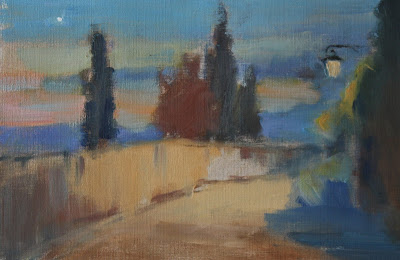 |
| (c) Maggie Siner, 2015 |
During the recent workshop in France, our fearless leader, Maggie Siner, urged us on to work well into the nighttime. A full day of painting was not enough--the evening beckoned with nocturnes! Some of the most lovely and original work of the week came during these evening painting sessions. The top photo is one of Maggie's nocturnes, painted in the little hamlet where we stayed. Fantastic! Nobody does it like Maggie! Just below is Bob Dodson's beautiful painting--painted a few yards down the road. I love the surprising stripe of lavender in Bob's painting. And Bob says that somebody inside happened to turn on a lamp just as he was finishing his painting, so he grabbed that beautiful little bit of orange.
 |
| (c) Bob Dodson, 2015 |
Back home, I did a little research on the history of nocturnes. I read that James Abbott McNeill Whistler coined the term "nocturne" as it applies to paintings. Before Whistler,
 |
| (c) Mimi Kline, 2015 |
The painting immediately above is from the brush of Mimi Kline, and was one of my favorites of the evening when we painted past sunset, after a picnic dinner in the field. It was not truly dark yet--just that magic twilight time. But Whistler used the label "nocturne" for twilight paintings, so this one counts! I loved the way that Mimi captured the hilltop village of Bonnieux. And that darkening sky in shades of blue-toward-red (aka "lavender") is a real visual treat.
 |
| "Nocturne in Blue and Silver--Cremine Lights James Abbott McNeill Whistler, 1872 |
Painting nocturnes is notoriously difficult. For one thing, you can't see your canvas very well! Even with equipment such as a headlamp (like miners wear), seeing is not ideal. And as the light leaves the sky, our eyes begin to lose sensitivity to color. Our cones cease to be very useful, and our rods, which aren't much good at discerning color, are doing all the seeing. Makes for some interesting dynamics. Just above and below are two wonderful nocturnes by Whistler. Like all great masters, he makes it look so easy!
 |
| "Nocturne in Black and Gold--The Falling Rocket" Oil on Wood, 23.7 x 18.3 inches James Abbott McNeill Whistler, 1875 |
I must confess that I did not paint any nocturnes during the workshop. Nightfall didn't come until almost 10 PM, and I was too exhausted at that point to start a new painting. But I did give it a go after the workshop. I found that the quickly disappearing light forced me to work tres vite, which kept my painting loose, and prevented me from over-working the canvas.
 |
| "Nightfall" 8 x 12, oil on prepared paper (c) Lesley Powell, 2015 |
I might add that photographing paintings of night scenes is pretty difficult also, so please accept my apologies if these images are not the best. More to come from the workshop...
No comments:
Post a Comment